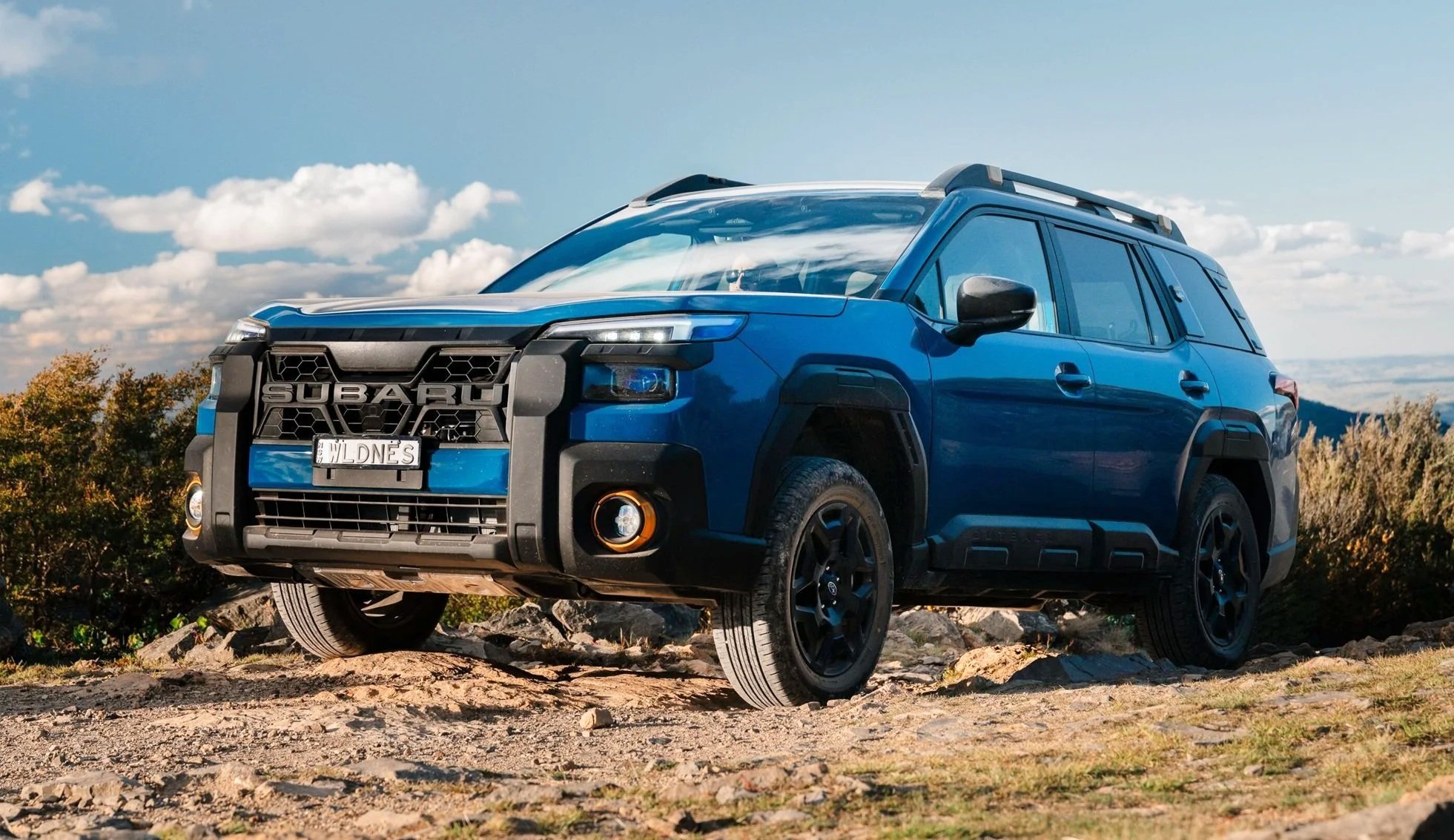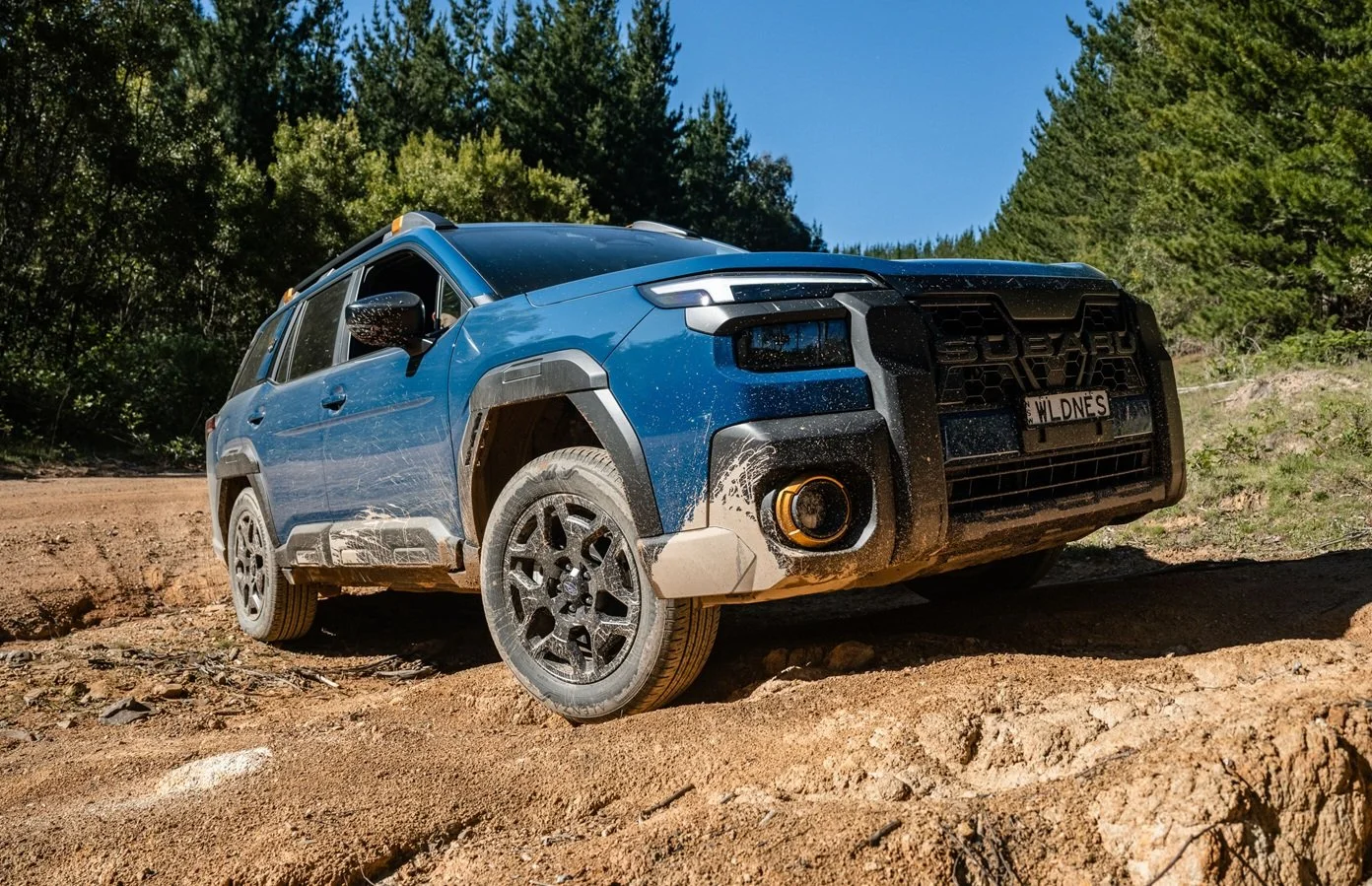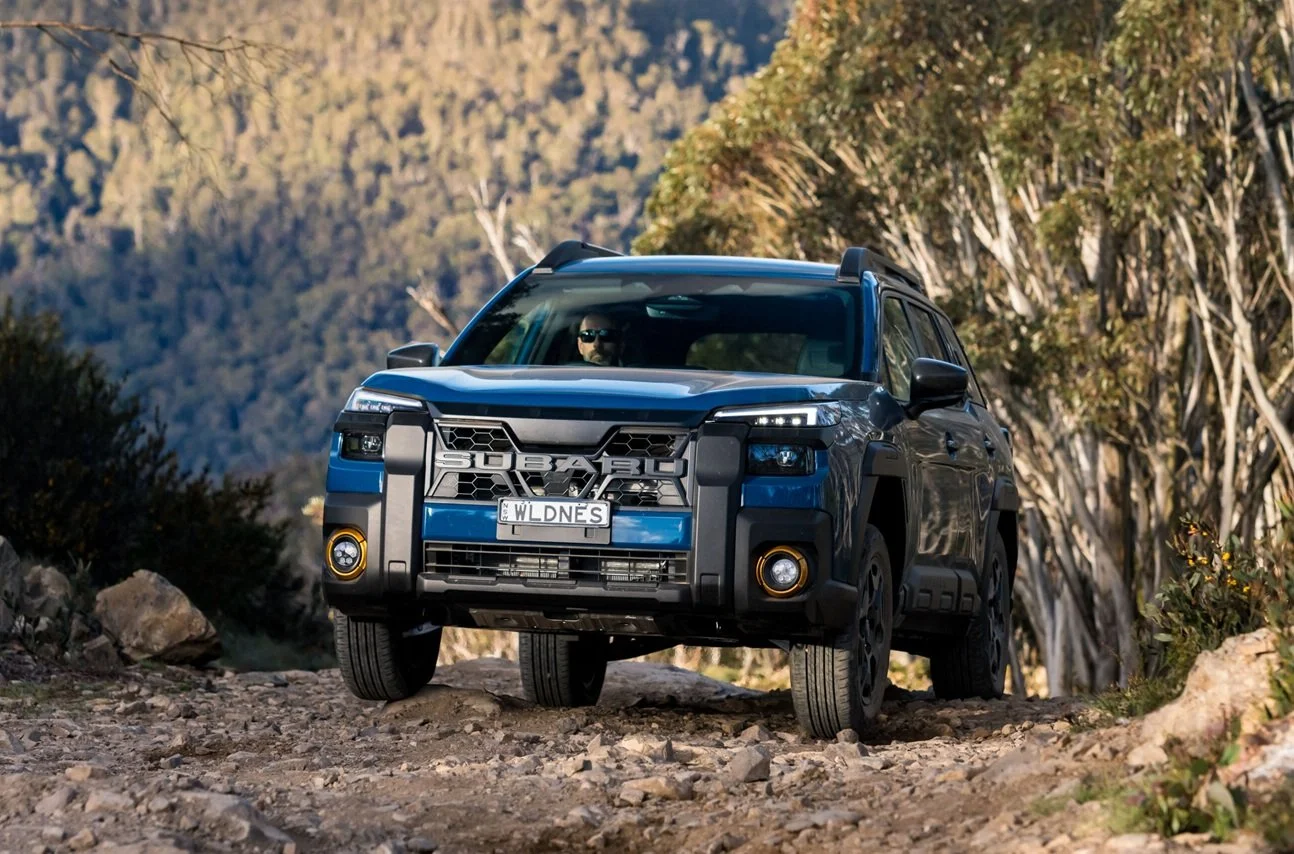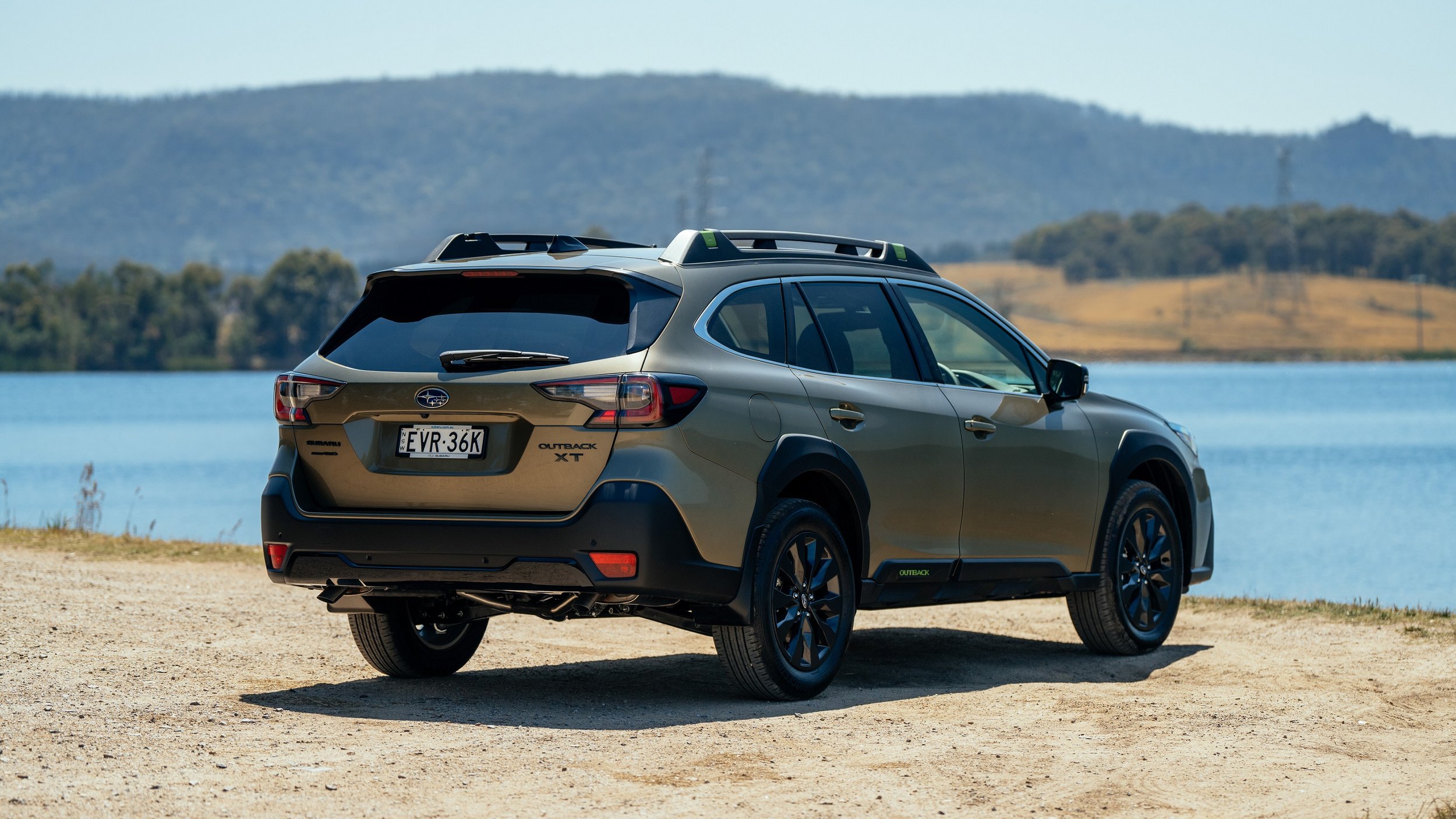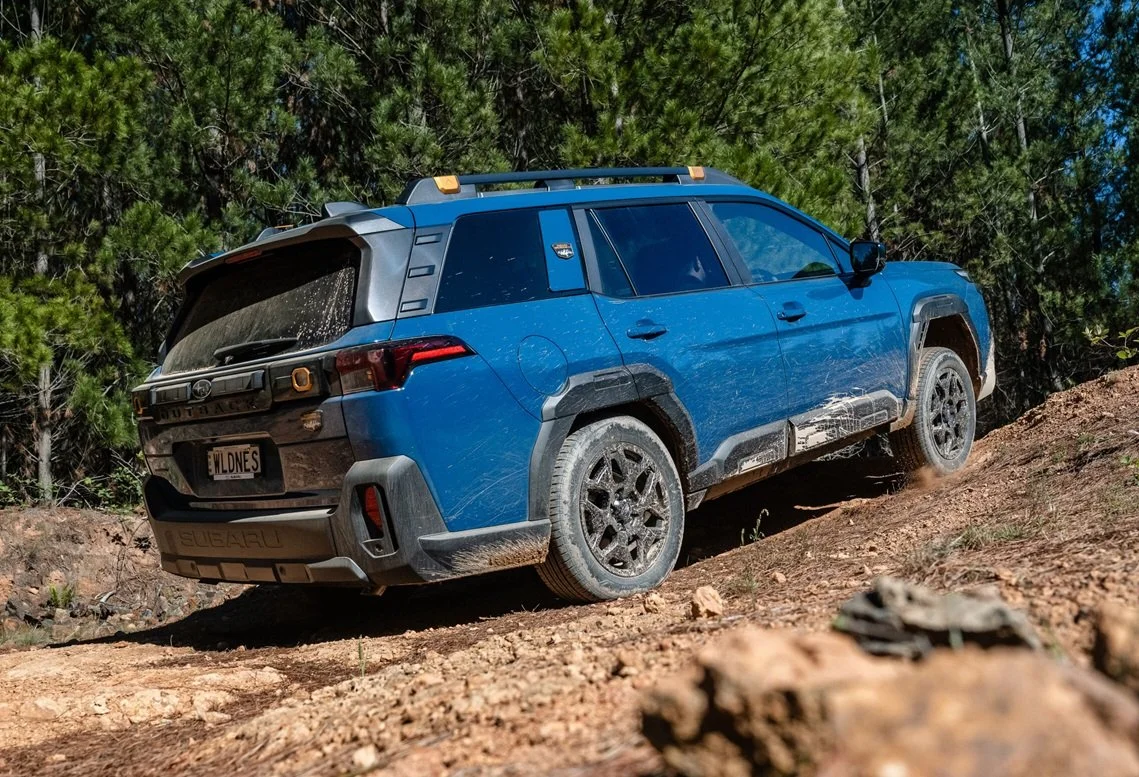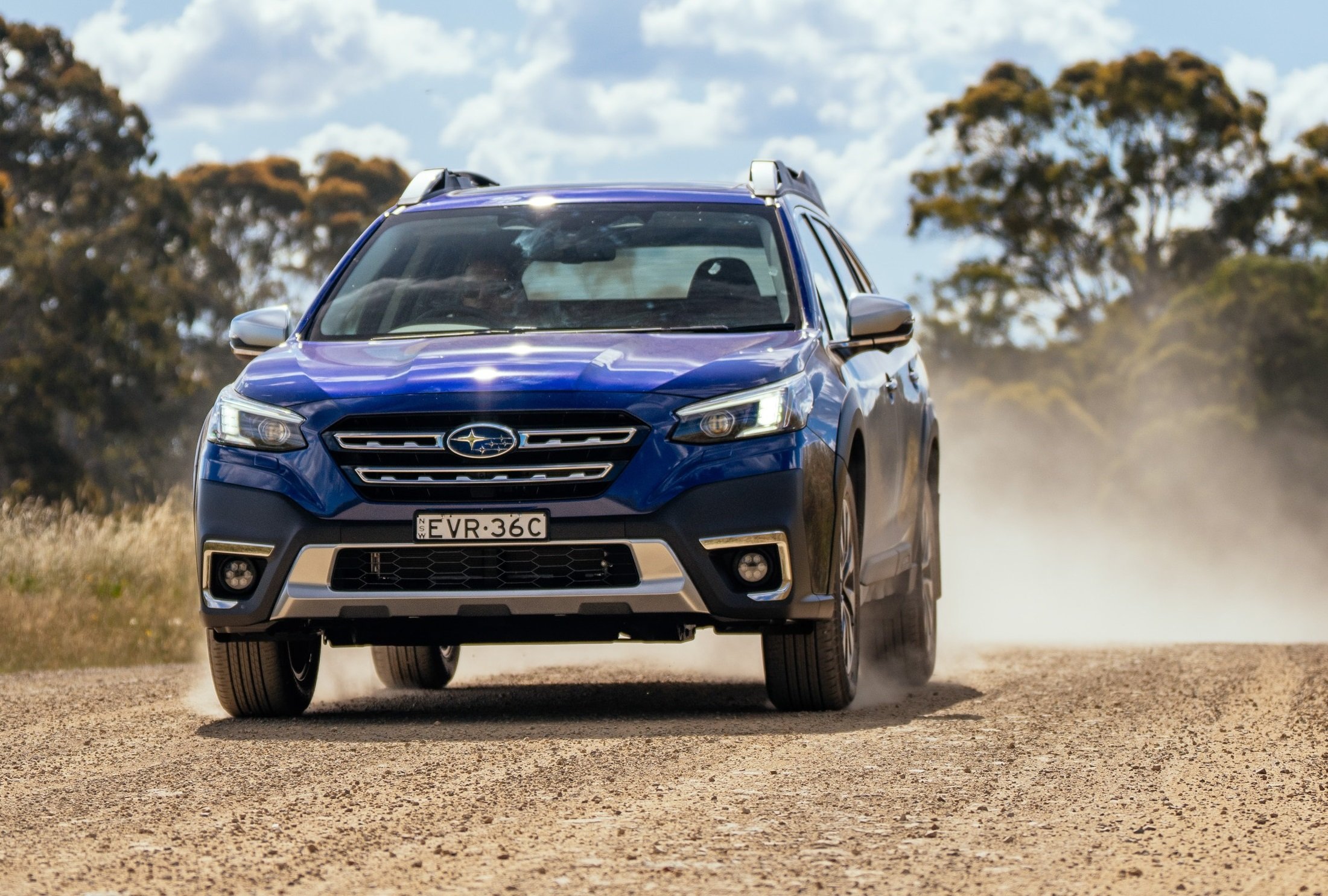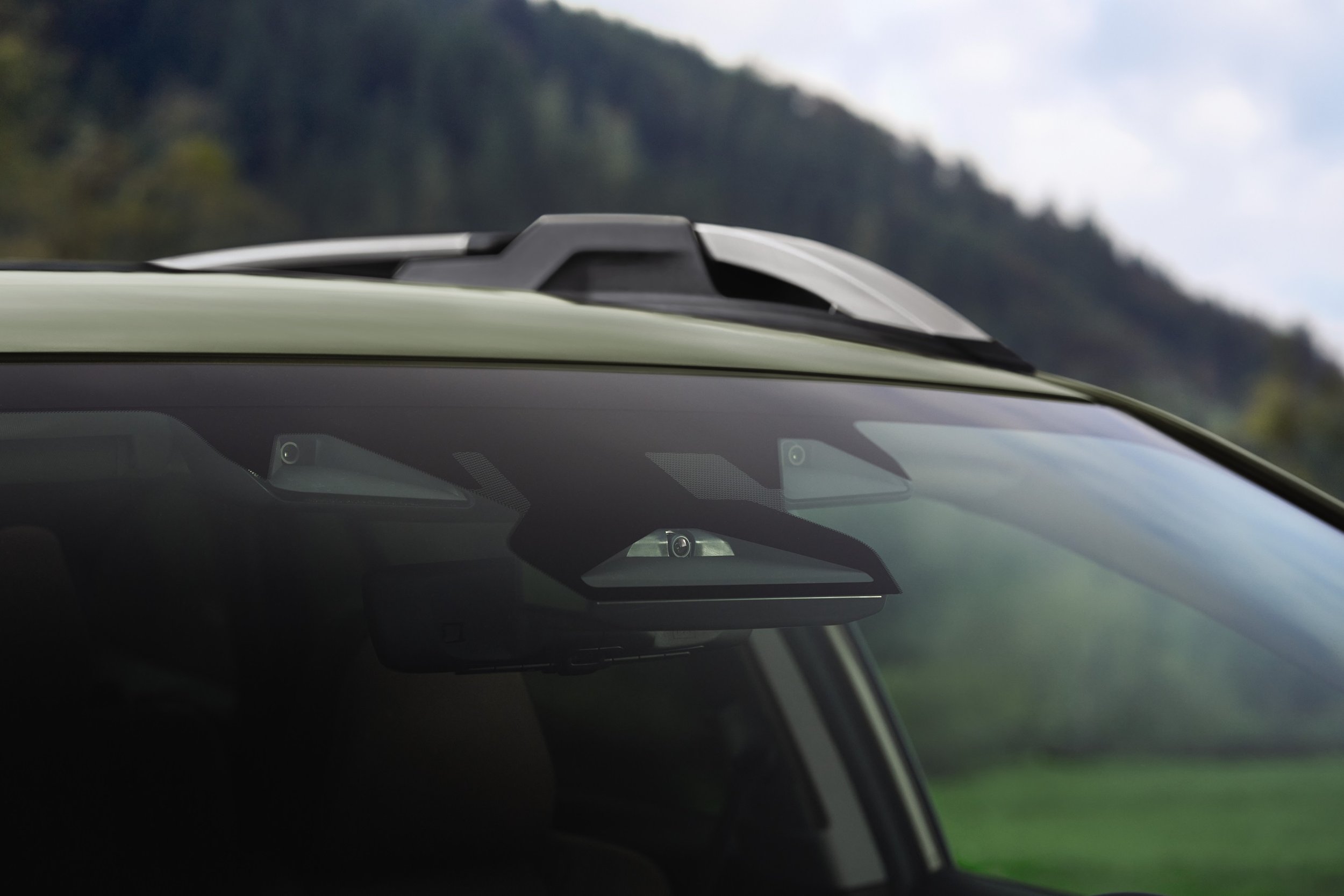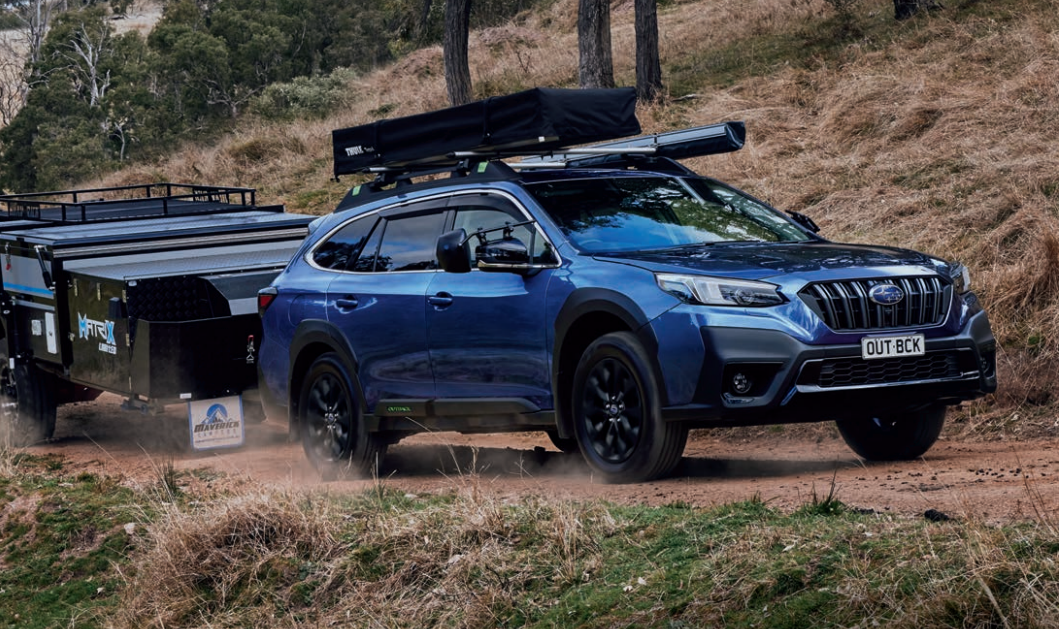Subaru Outback review and buyer's guide
New Subaru Outback is bigger, more aggressive and has a growling turbocharged WRX engine, making this large five-seat SUV wagon a seriously compelling soft-roader for adventurous families. With decent towing, excellent driving dynamics and even a reasonable pricetag, there’s got to be a catch. Right?
THE SUBARU OUTBACK is a practical, family-centric SUV with lots of luggage space, proper all-wheel drive and good ground clearance, now with the punchy, snarling heart of a WRX and better soft-roading capability.
This clever, affordable and good-value family SUV might be the smart choice for modest family adventures that don’t require hardcore 4X4 performance off-road, but instead want a civilised, safe and reliable 5-seater.
A lot of noise has been made of the new Outback ditching its raised wagon-based roots and going for a proper full-sized SUV shape. Purists will decry the sacrelige and scream that Subaru has lost its way, but if you think constructively and objectively about it, this could actually be the best thing to happen to the Outback.
In a car market full of dull SUVs that have gone hybrid, ditched their diesel powertrains and offer front-drive-biased and on-demand all-wheel drive, Subaru has actually made the uncharacteristically bold move to make the Outback stand out. And go like stink!
Sure, you still get the naturally aspirated 2.5L Boxer we know from the outgoing wagon-based version which dates back to 2015 when that platform debuted. The atmo Outback continues now has just three variants.
But there’s now the option of a more aggressively styled, more off-road capable Wilderness variant at the top of the Outback range, with two distinct varieties, the ‘Wilderness’ and ‘Wilderness Apex’.
Subaru Outback should absolutely be on your shortlist, especially if you’re shopping for either a medium SUV (think RAV4, CX-5, Tucson, Sportage, Forester or Outlander) OR if you’re considering a 7-seater without the need for row 3 seats.
Large SUVs (where Outback is categorised) include the:
Hyundai Santa Fe > and Kia Sorento >
But if you’re pondering a 4WD like Pajero Sport or Prado without the explicit intent to go off-road, Outback is a good option if you do still want good all-wheel drive capability.
Outback has one foot, so to speak, in each camp: it can be small enough to be thousands cheaper than a 4X4 SUV, it can go a lot further than most 5- or 7-seat SUVs which don’t have as good a drivetrain, and it offers a big boot unencumbered by row-3 seats that might never get used (in some households).
With an Outback, you might not get the occassional convenience of seven seats, but that means you don’t pay additional cash for seats that statistically rarely get used anyway and which can add another 100+ kilos (which is fuel burned driving them around).
What doesn’t get acknowledged with 7-seaters is that they are a compromise - you have to sacrifice weight, cost, luggage space and entry/exit practicality for those row-3 occupants in order to give them somewhere to sit. Outback removes that burden to take the additional bums on seats by simply not having them. Yes, there’s an argument here for that being a fairly unscrupulous way to solve that problem.
The top-spec non-Wilderness version of Outback, the ‘Touring’, is priced at about $63,000 which is about $5000 below a base model Toyota Kluger GX at a whopping $68,000. And Kluger only has on-demand all-wheel drive (we’ll get to that), weighs nearly 300kg more, and can only carry 1150 litres or cargo versus the 1810 litres of potential valume you get with the Subaru (measured to the roof).
The Kluger outsells Outback most months of the year, but if you actually have to change a flat tyre, the Outback runs with a full-size spare while Toyota can only manage a temporary space-saver - and yet the Subaru is a centimetre shorter in length. Outback is a much smarter package.
One of the grossly underrated aspects of an SUV like the Outback, which is essentially a Legacy wagon with uprated suspension, is that the body itself isn’t actually that comparatively tall compared with a lot of other large SUVs. This gives the rest of them a very high roofline, one that can be very difficult and potentially dangerous to access when washing your car.
With an Outback the roof is actually relatively accessible when you’re dealing with soapy water and heights. This same sentiment applies to accessing the wipers to change the blade rubbers, or just cleaning the windscreen itself.
Something else you might appreciate on an Outback is that, having a more conservative set of 18-inch alloy wheels (including the full-size spare), means in the event of a flat you’re only lifting a wheel and tyre weighing about 12-15 kilos, not the 15-20-odd kilos of a 19-20-inch wheel on some larger SUVs.
Having said that, on the new Wilderness variants it’s good to see Subaru hasn’t tried to take the populist route and upsize to bigger 19-inch alloy wheels, because the 225/60 profile tyres are an excellent balance of on-road comfort and quietness with the durability for gravel roads and toughter, lightly rocky tracks where a low-profile tyre risks pinching, punctures and rim damage.
And with that in mind, it’s important to highlight here that the Outback Wilderness is NOT a hardcore 4X4, no matter how desperately Subaru Australia (Inchcape) wants to sell that idea to you.
It is definitely a welcome upgrade to the tired old Outback range, but this is strictly a soft-roading SUV that is going to tolerate more than the typical family 5-seater, but must be driven conservatively and not into the terrain meant for low-range transmissions, high wading depths and chunkier all-terrain tyres.
After a major platform facelift of the Outback in 2021, it’s time to say farewell to the raised Legacy station wagon badged as Outback. The current generation of beefed up Legacy-turned-Outback is now a dedicated body-on-frame SUV.
This has two major knock-on benefits. You have a bigger overall vehicle, meaning more space and luggage, but it also means that it won’t be as neatly packaged as the outgoing platform. Being a bigger vehicle, it’s gained weight, so it’s be slower in non-turbocharged form. But it’s probably also going to be a more functional vehicle in many respects.
This means Outback will now be a dedicated large SUV platform as Subaru streamlines its products into sharing model fundamentals. So what else is new?
Well, being on a bigger SUV platform means you’ll have to think less about how to pack the boot, for starters - one of the inconvenient flaws about the outgoing model that is hard to quantify until you’re actually in the ownership period.
Unfortunately, it seems the built-in roof crossbar system is gone from the old Outback - arguably one of the outgoing model’s best features. But obviously you can buy genuine Subaru crossbars.
What is good with these factory rails is Subaru does now actually provide a lateral load rating, meaning you can tie ropes, secure tarps or fix side awnings to those rails with the knowledge of how much strain you can put on them.
In addition to being 2 inches taller, it’s going to offer 56 litres of additional luggage space taking it from 522 litres currently to 578 litres in the new one. With the rear seats collapsed, that’s roughly 1839 litres, an approximate 3 per cent increase, or a 10 per cent increase in terms of having the rear seat deployed. So overall, the practicality remains in that sense, at least.
If Australia gets the Wilderness “off-road pack”, which is unlikely given that we get our Subarus from Japan (not Indiana, USA where the Wilderness is built) we might get an extra 19mm of ground clearance compared with the outgoing Outback. But otherwise we won’t see any changes in ground clearance over the current version.
The standard 18-inch alloy wheel diameter remains functional in soft-roading driving conditions and running an all-wheel driveline that needs to split the tractive effort four ways at all times. It remains to be seen if we get a full-size spare as has been tradition for the last decade with Outback. US versions get a space-saver - so fingers crossed Inchcape Australia, the local importer, puts its foot down in this regard.
Inside, the gargantuan central tablet touchscreen is gone - thank the motoring gods (depending on your perspective; if you like big screens, this will be a let down for you). But there are still screens, screens, screens. There’s a 12-inch job as the primary dashboard infotainment centre. Then there’s another 12.3-inch one ahead of the driver and available on all model grades (in the US, at least), and a tertiary screen dedicated to the HVAC buttons, yes buttons return, simply indicate temperate, fan speed etc.
But yeah, the buttons are back for the HVAC system which is a sweet relief for anybody who likes being able to drive and operate the vehicle in extremely hot or cold conditions regardless of whether the screen itself is operational. As in, if the screen dies, at least you can still operate the AC using the buttons.
Somehow, in the midst of all the dramatic styling changes, the tweaks to functionality and operability, nobody at Subaru thought to do anything with the same old steering wheel we’ve seen on Outback since 2015.
Despite being categorised as a large SUV, the Outback will remain a 5-seater regardless of the fact it’ll continue competing with Kia Sorento, Hyundai Satna Fe and Palisade, Toyota Kluger and Mazda CX-70.
Here is a brief list summarising the key features coming to the new Outback:
12.1-inch infotainment touchscreen
12.3-inch digital driver’s display
Wireless Android Auto and Apple CarPlay
Advanced Adaptive Cruise Control
revised X-MODE
Symmetrical All-Wheel Drive system w/ faster centre differential lockup
220mm of ground clearance
19-inch wheels (certain models)
2.4-liter turbocharged Subaru Boxer engine (XT models)
wider-angle EyeSight mono camera
Also coming to the new Outback range will be the long-awaited Wilderness package. It’s Subaru’s attempt to sex-up the Outback to appeal to give it a tougher, more masculine edge… and it kinda works.
And before you ask, it’s more than just an exercise in stickers and cladding. But they are present, of course.
There will be two variants of Wilderness - the standard ‘Wilderness’ and the ‘Wilderness Apex’. Both get the 2.4-litre turbocharged Boxer engine from the WRX.
FEATURES & PRICING
There’s essentially 7 variants of the current Outback range, which will be replaced by the incoming model in 2026.
There’s three variants with the ‘XT’ badge with the 2.4-litre turbocharged engine from the WRX, and four with the naturally aspirated (non-turbo) 2.5-litre engine.
Let’s take a detailed look at the base model Outback, because it’s so affordable there’s a good chance you might be content with what it has to offer.
Outback base model | $49,650 driveaway approx.
Here’s what you get by default in a sub-$50K Outback:
Tyre pressure monitoring
Dual X-Mode
‘Sport’ driving mode
18-inch grey alloys (225/60 Bridgestone highway tyres), full-size spare
Built-in roof crossbars
Driver monitoring system: distraction warning, drowsiness warning, facial recognition, climate control setting (last used)
Rearview reverse camera
EyeSight: All features:
Vision Assist package: adaptive driving beam (ADB), blind spot monitor (BSM), EyeSight assist monitor, lane change assist (LCA), rear cross-traffic alert (RCTA), reverse automatic braking (RAB)
LED steering-responsive auto-adjusting headlights
LED interior lighting
Dual-zone climate control
4 cargo tiedown points
Some might jokingly call the entry-level Outback the ‘poverty pack’, but it is anything but that. You get substantial list of gear almost to the point of being exhausting to read. So let’s do the headline features.
Base Outback gets the big centre screen (11.6 inches - portrait orientation, too - bucking that ‘landscape’ trend). But, there are refinements which might make you think Subaru might actually be listening to customer and media feedback. For example, HVAC controls are now fixed to the bottom portion of said touchscreen, withing easy reach and view of either driver or front passenger, where previously they were put behind an irritatingly distracting sub-menu process that simply didn’t need to exist.
Happily, that’s fixed now. Well done, Subaru.
Outback actually looks quite smart these days thanks to LED lighting which is everywhere, including headlights, indicators, taillights and daytime running lights, even in ‘poverty class’. Respect to Subaru for packing all that in, for the basic price, and remaining competitive.
Normal 2.5-litre atmo Outbacks get 2000 kilos of braked towing capacity, or there’s notionally 2400kg in the 2.4 turbo - but I have a separate report on Subaru’s big towing claims vs reality >> which you need to watch in relation to that. Essentially you’ll have almost zero payload available if you stick 2.4 tonnes on the back. Not to mention it’s inherently unsafe to put that much weight behind a 1.7 tonne vehicle, speaking as an engineer.
It’s okay to settle for the atmo Outback. It will hustle as you learn how to get the most out of it. After a few months of driving, you’ll quickly figure out how to drive it ‘in preparation’ of prevailing traffic conditions.
Premium | $53,280 driveaway approx.
‘Sport’ models are given away by the green roof rail inserts and ‘Outback’ lower door sill badging. But it’s not all bad news. keep reading…
Sport | $54,600 driveaway approx.
Adds:
Satellite Navigation
Black metallic 18-inch alloys
Side view camera and front view camera
Heated seats - driver, front passenger & rear outboard
Roof rails - but no crossbars; allows you to fit abnormally sized cargo baskets etc
Hands-free power tailgate
Water repellent seat trim
Sports pedals
8 cargo tiedown points
Touring | $57,700 driveaway approx.
Adds:
Auto door mirror adjustment with 2-position memory
8-way powered driver’s seat w/ auto adjustment & dual memory position
Sunroof
CD player
9-speaker Harman Kardon stereo w/ subwoofer and amplifier
Heated (premium leather) steering wheel
Nappa leather highlights
And now the turbo versions.
‘Sport’ models are also given away by black alloys, rear badging and the lack of light-duty roof cross rails.
Sport XT - $59,000 driveaway approx.
Gets:
2.4-litre turbocharged Boxer petrol engine
Water repellent sports seat trim
Dual function X-Mode: ‘Snow’ & ‘Dirt’
Heated front and rear-outboard seats
Sports pedals
Dual-exit exhaust pipes
6-speaker stereo
Lacks:
auto dipping door mirror (the one that tilts the passenger side to ‘help’ you, except it shows you the kerb you’re already on top of, instead of the one you’re trying to dodge.)
auto seat adjustment
driver’s seat memory function
auto rearview mirror dimming
heated steering wheel
ventilated (cooled) front seats
manual thigh support (ideal for taller drivers)
The lack of integrated roof crossbars on the Sport is a counter-intuitive thing. In one sense, having built-in crossbars you can deploy at a moment’s notice is very handy. But, fitted to base and Touring models, they’re absolutely not designed for heavy loads - and nor should they be, because they’re rated for safety and stability to about 80kg.
However, while you may not have kayaks that weigh 40kg each - unless they’re bloody big and made of something worse than fibreglass - the crossbars are limited in how wide your cargo can be.
Losing the crossbars and gaining the normal rails means you can attach heavier duty cross bars in the aftermarket or from Subaru to do those bigger jobs of carrying your gear into the wilderness.
Having wider crossbars, especially those with overhang, gives you additional real estate to loop straps around and hook them onto themselves, or to simply give you somewhere outside of your cargo to tie ropes to.
Touring XT - $63,000 driveaway approx.
Gets:
2.4-litre turbocharged Boxer petrol engine
Leather seats front and rear
Dual function X-Mode: ‘Snow’ & ‘Dirt’
Heated front and rear-outboard seats
Sports pedals
Dual-exit exhaust pipes
Premium 8-speaker Harmon Kardon stereo
And all the bits the ‘Sport’ lacks like:
auto dipping door mirror (the one that tilts the passenger side to ‘help’ you spot the kerb before you clobber it)
auto seat adjustment
driver’s seat memory function
auto rearview mirror dimming
heated steering wheel
ventilated (cooled) front seats
manual thigh support (ideal for taller drivers)
TRANSMISSION
The Continually Variable Transmission in Outback is very smooth and nicely integrated. A CVT, if you don’t know, is basically an adjustable pulley system, as opposed to actual toothed gears locking into place like in a conventional gearbox.
There are carmakers still not getting their CVT anywhere near as refined as Subaru has.
Outback’s CVT has a manual mode, too, which is very nicely tuned to what feel like real epicyclic gear ratios. They don’t really feel like ‘steps’, were it not for the engine sound, albeit not nearly as droning as it used to be. It tends to quieten down fairly quickly if you spike the revs. But please understand, CVTs are designed to spike the revs, because that’s how this transmission works, by giving you peak power on-demand.
The only tangible drawback with the transmission here is not co much the CVT itself, it’s the selector inside the cabin. If you’ve got a phone poking out the top of the cramped storage cubby fore of the shifter, shoving it into park can wedge your phone.
Paddle shifters do actually play a role in operating the Outback in any kind of dicey terrain or twisty mountain roads in the wet or at night, whereby you don’t want to be taking your eyes off the road for even a split second. And they’re pretty quick to respond, which is nice.
ENGINE
Senior executive Subaru dudes said the 6th generation Outback’s engine was 90 per cent new back when they gave it the big makeover for 2021, but today, even in the new 7th-gen, it’s the same old 2.5 they’ve been using for dinkey’s years. And no, that’s not a criticism, nessarily.
It’s still 2.5 litres and atmo, and a boxer, and it’s perfectly adequate for 90 per cent of Outback owners. In fact it is perfectly fine for the vast majority of car buyers, to be honest. It’s reliable, it’s pretty furgal (without making dubiously high fuel economy claims, ala RAV4 or anything Chinese hybrid), and it’s got just enough grunt to be satisfactory; but again, it’s adequate.
The 2.5 engine, now with direct injection for 138 peak kilowatts, is refined, but mediocre; adequate - meaning it’s exactly what a lot of people need/want. If you’re not one of those people and you’ll always take ‘more’, then you’re in luck.
It is, therefore, with deadset joy that they have finally brought the 2.4 turbo petrol engine here, to Australia. This a real step forwards for Outback - they dropped the 3.6, and have replaced it with something properly punchy and - holy smokes - even inspirational.
So there’s now a performance option on the table for Outback. And whoever allowed it to take so fricken long, hang your head in shame. Some people want their family vehicles with performance from the get-go.
And it’s a significant performance increase of over 30 per cent compared with the atmo 2.5. It’s no wonder that with an additional 10-15 per cent throttle input the thing just scurries on up the road. Much like the gnarly WRX from whence it came >>
Just remember, the 2.4 engine in the outgoing version takes 95 RON premium petrol, too. The new 7th-generation Outback Wilderness, with the same 2.4 turbo has been re-tuned to take 91 RON - according to details released by Subaru Australia (Inchcape).
So make sure to factor in 95 premium petrol if you’re heavily scrutinising running costs, although I’d suggest that’s something of a fool’s errand with fuel because it’s particularly cheap here in Australia, on a global standard. If you’re buying a $50,000-$60,000 SUV, a few cents per litre isn’t going to make much difference over the next five years of ownership.
The performance sterilisation all those years ago seems to be slowly diluting. So that’s nice if you want a utility-themed family vehicle that’s actually sporty as well.
They needed a bit more passion in the boardroom at Subaru central - and it seems it’s coming back. This has been the biggest criticism of current Subaru Forester: review & buyer's guide >>
Hopefully the 2.4 turbo will be destined for Forester soon, too. Having said that, it’s still a good vehicle, ultimately, for most conventional SUV buyers. Check it out, as well as Outback, if you need a comfy, reliable and capable five-seat SUV that’ll go further than the other soft-roaders.
Now, if you want to know why the new 2.4 turbo Outback is such a big deal in technical terms, particularly in relation to its dinosaur predecessor, the 3.6R, you’ll want to watch my in-depth report on this here:
So, is the 2.4 turbo worth the extra cash upfront? It depends on what you want and what kind of driver you are. If you want to put your foot down and dash forward to round up some sluggish truck on a long uphill freeway, you absolutely want the 2.4 turbo.
But if you’re quite happy sitting behind said truck while it lopes over the Great Dividing Range, or if you’re just a school taxi for your kids with absolutely no appetite for giving it the beans - stick with the atmo Outback.
FUNCTIONALITY
Staying in positive territory, luggage space is a winner in Outback, for both the outgoing version and the new 7th-generation.
Length is the most useful dimension, of course, and Outback offers heaps of that thanks to . Size really does matter. And Outback really packs it in.
Despite not being the biggest SUV of them all, Outback has always taken long items well.
And while you’re…down there, under the boot floor is a full-size spare wheel on all variants. So, in the event you do gash a sidewall on some sharp, malignant rock, once you’ve changed it over, you’ll be back up to normal speeds, including 110km/h on the freeway, at night, in the wet, with sleeping kids and wife snoring away as you negotiate B-doubles and 1/4 gradients.
But overall, what I’m saying is: I did not feel like a second-class citizen driving the so-called ‘poverty’ Outback. Recommended drive-away price is about $45,000 for the poverty - but if you spend about $5000 more and buy the Sport, you get a bunch of convenience features: Sat Nav (pro tip: Google Maps is just better) plus different 18-inch alloys, front- and side-view cameras, four heated seats - four - and a hands-free powered tailgate. Oh, and sports pedals - be still, my beating heart. That’s on the mid-spec Outback AWD Sport for about $49,500, drive-away, undiscounted.
Regular non-turbo Outback drives perfectly fine around town, which will suit the majority of buyers.
Perversely, you lose the roof rails with integrated cross bars - one of Outback’s cleverest features. It’s standard on Poverty. But not on Sport. And, it’s back, on the top-spec Touring. But not on Sport. So you can take the family to the snow and enjoy those toasty heated seats - but leave the skis behind, unless you purchase a set of crossbars separately. Interesting product planning decision there...
Of course, if you hurl the budget into the weeds you’re looking at $3500 more, for the Pimp’s Cadillac of Outbacks - the AWD Touring, for about $53,000. Undiscounted. Drive-away. This is a lot cheaper than, for example, a fully loaded Santa Fe or Sorento - although admittedly these two, and the CX-9, all offer seven seats.
You also get leather on Touring - leather accents, actually - definitely not a hit with the vegans. Plus an electric sunroof, fat beats from Harmon Kardon, a CD player (for your antique music), plus a heated steering wheel, dual memory driver’s seat, glossy alloys (but still 18s). No ventilation on the seats, though, for our long, hot, sticky, sweaty summers...
On balance, I’d suggest Outback is a net evolution for Subaru - long awaited, but a proper step forward, in most respects. Subaru does have its bolted on fans. There’s a lot of people who will only ever buy another Outback, until they prize the keys from their cold, dead fingers. They don’t shop around. The Symmetrical AWD and the awesome customer care - it certainly builds loyalty.
Plus, 213mm of actual ground clearance, so Outback has some legitimate off-road ability. You even get the two-stage X-Mode in the base model, for dirt/mud or deep snow.
Outback has a lot of appeal - especially if you are in Club Conservative. Nothing wrong with that.
But the passion deficit is a thing. It kills brands. Just look at Honda and Nissan - both having near-death experiences today. I think some other brands - like Hyundai and Kia - are taking the fight to Subaru, and their incremental evolution is proceeding at a faster rate than Subaru’s.
And maybe that’s not a problem today - but if the trend continues, exacerbated by Subaru’s current ‘passion deficit’ there’s a risk of being overtaken, in the medium term.
Even bolted-on customers can become detached over time. You know that expression: ‘Be the change you wish to see in the world’? I think Subaru needs to channel its inner product planning Ghandi, and reverse the tide on passion - if only to protect the terrain it has fought so hard to occupy today.
I'll help you save thousands on a new Subaru Outback here
Just fill in this form.
No more car dealership rip-offs.
Greater transparency.
Less stress.
INTERIOR
It’s fair to say not everyone was a fan of the sixth-gen Outback’s big, portrait-oriented tablet-style touchscreen. Not only did it feel like just copying Tesla and Ranger (who are not Subaru’s core demographic), it also dominated the cockpit disproportionately, thanks mostly to the fact it was already a fairly enclosed space.
The outgoing Outback had a nice interior that was dominated by that love/hate vertical touchscreen; but it still feels like a wagon with a driving position to match.
That huge screen not only took over the cockpit, it defied Subaru’s motto about ‘confidence in motion’ and being ‘all 4 the driver’. It was slow and hid too many functions inside menus and it almost entirely removed the buttons that made Outback simple and functional - and familiar.
But things are different now. They’ve changed things, and it’s emphatically for the better. Just appreciate the landscape-oriented screen which its inset, so it gets a small border at the top (which is where the driver stalking camera is fited), that doubles as somewhere to rest your fingers when pushing icons at the top of the screen.
Same goes for the little shelf at the bottom of the screen where you can also rest fingers while searching for the right thing to press.
That centre screen - yeah, it’s big, but like a lot of carmaker integrations, they could learn a lot about being slick in the GUI (graphic user interface) from Apple and/or Google. Because, while it’s better than the old Outback’s supposedly steam-powered touchscreen, the new one still has a lag after pushing icons.
Speaking of which, the icon to open vehicle settings (in order to disable the lane-keeping ‘features’ and the still kinda rough and unrefined ignition auto-stop start) is on the wrong side of the screen - at least it was untile they put the auto-stop/start button in the centre of the home screen. Hooray. But that ‘vehicle settings’ button, it’s on the far left, not the right (the driver’s side) in our market. This means your eyes come off the road, ever briefly, in order to push the icon, which is also too small.
Regardless, you’re gonna have to make friends with that screen and learn how to play it like a violin. Once you do, you’ll be able to hit those icons with your eyes closed; maybe even integrate those ‘disable’ functions into your morning start sequence routine. Brake - ignition - mirror check - seatbelt - screen - lane-keeping off - stop/start off - heated seat on - reverse.
At least the auto park brake release is pretty smooth.
DRIVING
Just quickly, there is also a tangible improvement in the way the 2.4 Outback handles, particularly on Australian roads.
See, the rather American-ised nature of Subaru’s product line-up means they lean more towards softness (in the suspension) and dull handling characteristics, which in Australia typically leaves drivers wanting more.
While the naturally-aspirated Outback takes a bit longer to recover from various bumps, dips and crests, sometimes three or even four cycles of the dampers and springs before composing itself, the 2.4 does not.
Subaru says:
There has been a tailored suspension tune for Subaru Outback XT variants.
To suit the 2.4-litre DIT Boxer engine, the damping force of the front and rear dampers, and the spring constant of the front coil springs, have been tuned.
This tuning helps deliver both driving stability and ride comfort.
This updated Outback, in concert with all the other tweaks, feels much better, much more compliant. Two cycles of the suspension over similar terrain is noticeable, even to the more mediocre drivers among us. So there’s that.
Why choose all-wheel drive?
Outback’s primary advantage in the market today is Symmetrical all-wheel drive, which countless people, especially motoring journalists, think gives you ‘more grip’ or ‘extra traction’ or somehow ‘enhanced traction’ whenever it rains or it’s not bitumen beneath your wings.
Strictly speaking, that’s not really accurate. If you want a more technical understanding of how tyre grip & friction works, click here >>
What AWD actually gives you is greater predictability and reduced wheelspin when the road turns to slush.
The freeway is four lanes wide, it’s pouring with rain, you can’t see a thing because of the spray and there’s standing water everywhere. Or that grassy campground is blanketed in September frost, maybe even your long farm driveway is all chopped up from a week’s worth of rain and your eldest son’s dirtbike. AWD means you get a more progressive transition from grip to slip - in particular when applying power.
Essentially, all four wheels are driving all the time, and that means, for any given level of overall tractive effort, each wheel is only required to deliver, broadly, half the drive torque, compared with most of those front-drive-only SUV competitors.
Result: Less loss of traction from the driving wheels. Symmetrical AWD is also better than many on-demand all-wheel drive systems of competitors, which can take too long to catch up with changes in either the traction underfoot or the driver’s acceleration demands. I say ‘too long’ because by the time the computer detects wheelspin, you’ve typically lost your momentum and are basically stationary, so the coefficient of friction (and therefore the required energy to get going again) is greater than when you had momentum.
A rally-inspired Outback will help Subaru sell more units and ignite the passion its customers miss.
But because you’ve got minimal or zero grip (tyre interlocking), you’re stuck and that ‘on demand’ AWD can’t save you. Point being, don’t lose traction or momentum in the first place. Buy a Subaru.
You do not want to be in a position where you drive down some fire trail to an idyllic campsite, where you can burn the dinner and commune with nature, and then it drizzles overnight. Because in the morning, if you try to get out and don’t have any momentum to start with, you generally won’t be able to drive out in a 2WD/on-demand system.
Regular trips to the snow, launching a boat on a ramp, rural property with driveway from Hell - all excellent reasons to own the AWD Outback in any variant or powertrain.
SAFETY
Virtually all the safety systems are standard which, admittedly, are a bit intrusive at times. But it’s the nature of the beast - modern cars, that is. Poverty Outback is, essentially, fully-loaded on safety - including driver monitoring and autonomous emergency steering. This is one area where Outback really delivers across the range, and you do learn to adapt to these systems, generally.
And even the more annoying features like lane-keeping are no longer the nanny overload forcing you into the centre of your lane. It’s more of a very gentle coercion, which is very easily overridden now, especially for anybody who likes to position the vehicle to one side of the lane in certain driving conditions, like ascending mountain roads where oncoming overloaded utes could clean you up as they round the same turn.
It needs to be said that Subaru’s systems have, for a long time now, been generally the best example of not being overdone and intrusive. There are very few false-positives and the stereoscopic cameras don’t usually scream at you unless it’s feasibly relevant to you. I think this is the legacy of having developed their EyeSight safety gear years before anybody else was doing it in the mainstream brands. Subaru pioneered them and got the R&D done properly.
Adaptive Cruise Control
Brake Light Recognition
Intelligent Speed Limiter
Speed Limiter
Speed Sign Recognition
Lead Vehicle Start Alert
Emergency Lane Keep Assist
Lane Centring Function
Lane Departure Prevention
Lane Departure Warning
Lane Sway Warning
Pre-Collision Braking System
Pre-Collision Brake Assist
Pre-Collision Throttle Management
Autonomous Emergency Steering
EyeSight was one of the earliest mass market systems featuring adaptive cruise, emergency braking and vehicle-to-vehicle monitoring. Subaru developed the system using stereoscopic cameras developed from some of Logitech’s earliest webcam technology.
Essentially, Subaru still uses this kind of technology today, favouring the clever software and image processing method over sole reliance on infrared and sonar-based systems which you might recognise on vehicles with a smooth, shiny piece of plastic at the front of the vehicle, either in the grille or doubling as the vehicle’s logo.
For many years, EyeSight has been something of a benchmark in terms of offering adaptive cruise, lane-departure and auto emergency braking to mainstream car buyers at an affordable price, when premium brands were charging thousands on top of their already expensive cars.
But things have changed. The market has caught up and base models from Kia, Hyundai and Mazda all offer these safety features.
What matters with EyeSight is how well it’s integrated, how Subaru has designed its system to brake gently when vehicles merge in front, the way the lane-keeping and departure warnings are present without being alarming and panic-inducing - despite their occasional dim-wittedness.
Because they’ve been improving their system the longest, Subaru has managed to keep the false-positives and intrusions to a minimum. Although, I hate that the ability to deactivate these systems, compared with the previous model, have now been put being the touchscreen menu, rather than a simple one-push button on the dash above the driver’s left knee in the old car.
(Same goes for turning off the ignition stop/start, which defaults on every single time and cannot be permanently switched off, and has to be deactivated by accessing the vehicle menu in the touchscreen.)
Outback was tested in early 2021 under fairly recent ANCAP test protocol, but they have been superseded from 2023 onwards. This means Outback was not tested against criteria such as ‘vehicle submergence’ (however inapplicable that scenario is like to be), ‘child presence detection’, and specific pedestrian injury types like tibia & knee, femur, and pelvis protection.
However it did score pretty well in the vulnerable road user tests (these include cyclists and pedestrians). It performed poorly when head impacts were tested against the lower parts of the windscreen and pillars, but this is fairly common among similar tests on many vehicles. It was also marked down two points for failing to engage auto emergency braking to stop in reverse at 4km/h.
Having said that, that hallmark EyeSight collision avoidance system was flawless, meaning there’s a better chance you’re going to avoid the collision entirely over someone’s noggin actually collecting with that hard lower windscreen region.
In all the critical crash tests, Outback was pretty good. But there are two concerns as to how Outback’s safety standard will carry into the future because front-centre airbags are present in all new vehicle models coming out these days, particularly since the 2023 model-year. But Outback doesn’t have a front-centre airbag and that’s a bit concerning because it prevents or minimises head-to-head impacts during lateral impacts and that is one area Outback didn’t score any points.
The underlying issue here is that airbags are part of the vehicle’s platform fundamentals. You can’t just stick one in during some model update a few years later, otherwise Kia and Hyundai would’ve probably put curtain airbags in row 3 years ago, but couldn’t.
So Outback has to go another 5 years without that front-centre airbag. It’s one of the only large SUVs without one in 2024 and beyond, and that’s a bit disappointing considering Subaru makes a big deal about its safety credentials.
TOWING
Subaru has upgraded the frontal cooling of the new Outback with a larger capacity to dissipate heat compared with the previous model.
This is what was actually holding the old car back, not some rumour mill bullshit like the CVT’s reliability or some weakness in the drivetrain. It was simply a heat management limitation in the previous Outback’s radiator design which meant they couldn’t offer a towing capacity greater than 1500kg (braked) on the 2.5 or 1800kg on the 3.6R.
The new car, of course, now offers a segment competitive 2000kg of braked towing capacity, with 200kg of towball download, governed, of course, by a 2200kg Gross Vehicle Mass (GVM). This leaves you a payload of just 292kg if the full 2000kg trailer and 200kg of towball download limit are applied to the Touring spec. If you need max payload, I’d be going for the lighter base model and getting back an extra 35kg.
While the peak power output has increased just 7 per cent to the same as the old 3.6R, the new Outback in its heaviest Touring trim, is 1708kg with a full tank of fuel (63 litres of 91 RON).
As pictured in the brochure, try not to tow 2.4 tonnes with your 1.7t Outback, despite Subaru saying it nearly 10 times.
The Outback XT is being sexed up as a bigger towing option than the atmo version, and on a technical note, that’s true. But the notion of Outback pulling 2400kg - a trailer weighing about 500kg more than the Outback itself - is fundamentally sketchy from a safety perspective.
If you pull 2.4 tonnes with your Touring XT, you will be travelling solo because as pictured above, you won’t be getting many passengers or their luggage aboard for the big Easter camping trip to Dingo Piss Creek.
So be modest with your towing assignments for both the atmo and turbo Outback, keeping everything below the weight of the underlying vehicle which happens to be between about 1673kg and 1777kg, variant depending. The reason I say ‘about’ is because Subaru quotes tare weight, which excludes a full 63-litre tank of fuel.
Keep your trailer below 1.6 to 1.7 tonnes and you’re on the safer side of Newton’s Laws of Motion. That second law’s a doozy >>.
Subaru Outback sales, 2024
According to VFACTS data, Subaru Outback had a rockstar 2023 and 2024, despite being down slightly, locked in battle with Hyundai Santa Fe, Kia Sorento and Toyota Kluger. Also, the Kluger continues to going neck-and-neck with the Outback.
Here’s what the sales figures looked like, ranked in order.
2024 total large SUV sales (non-4X4)
DRAWBACKS
Unfortunately, the built-in roff rack crossbars on the outgoing Outback do not get reprised on the new version - arguably the Outback’s most redeeming feature, especially on the naturally aspirated version which doesn’t offer the performance of the 2.4T.
Yet Subaru North America has the cheek to inform us:
“Standard crossbar measurement markers help owners align and position crossbars for easier installation and accessory placement.”
Helpful for when you purchase your marked-up genuine Subaru crossrails or your more affordable (but still pretty expensive) aftermarket rails. Sure, that is useful having markers that assit with crossbar alignment, but it’s not exactly a problem screaming out for a solution. Especially when the old model already had a built-in solution Subaru has taken away.
What’s most annoying about this downgrade is that Subaru has made the Outback’s roof load-carrying functionality exactly the same as every other large SUV on the market. They no longer have that point of difference over other competitors who didn’t bother to innovate like Subaru did back in 2015 when the current generation Outback debuted.
MAIN COMPETITORS
HYUNDAI SANTA FE
The seven-seat Santa Fe defies any rational case for buying a notionally premium German SUV.
A stylish yet functional cabin is bookended by affordability particularly in the mid-spec ‘Elite’ version which includes third-row climate control, plenty of charging ports and leather seats. In addition to the clever push-button transmission selector, good towing performance and some funky modern design, there’s even an abundance of legroom for all ages.
A full-size spare wheel is mounted externally under the rear, there’s a choice of a hybrid or full-combustion powertrains, driving either the front wheels or all of them.
Santa Fe’s AWD system is active, meaning it’s always monitoring and managing grip. Deploy row 3 seats at a moment’s notice; choose your configuration between 7 seats, or a 6-seater with second-row captain’s chairs.
For more on Hyundai Santa Fe, click here ›
KIA SORENTO
Refreshed Sorento feels like a six-figure luxury SUV because it’s refined and drives beautifully. It shares fundamentals with Hyundai Santa Fe, but there’s a strong argument that Kia’s execution is better. The cabin and cockpit operations are slick and ergonomic, and there’s a third ISOFIX child restraint point (with corresponding top tether) in row three - making this one of very few triple-ISOFix SUVs on the market.
Kia’s rotary transmission selector is a dial to twist left or right for reverse, neutral and drive - a very slick piece of design great for doing U-turns, three-pointers and reversing a trailer.
Powertrains are all-wheel drive with an eight-speed dual-clutch transmission with the 2.2L diesel, or an eight-speed epicyclic-auto in front-drive with the 3.5L V6 petrol. There’s a full-size spare, tyre pressure monitoring is standard, and 2000kg of max (braked) towing.
For more on Kia Sorento, click here ›
MITSUBISHI OUTLANDER (7-seater)
Outlander offers the best of both the large and midsize SUVs. If you need a seven-seater on a tight budget, it offers three rows but in modest profile, without a soaring pricetag.
The 2.5-litre petrol engine is naturally aspirated, so it’s good enough without being punchy, and frugal enough without being ultra-conservative on the fuel-consumption front.
Legroom is OK in the front and second rows, but it’s kids-only in row three (but no child restraints for row three, so older kids only up the back.
If you’re unlikely to go far off sealed roads, the on-demand all-wheel drive system of Mitsubishi’s is decent enough to get you through most light mud, wet grassy carparks and steep, slippery driveways or take-offs at the lights. The brochure talks a big adventure game, but it’s not a proper 4WD. Mitsubishi also offers a conditional 10-year warranty.
For more on Mitsubishi Outlander, click here ›
MAZDA CX-80
The CX-80 offers a lesson for other brands on size, space, luxury and pricing, with seven seats, a beautiful interior and a range of grunty straight-six engines.
A smart choice for mostly metro-based families which venture to established provincial towns for holidays where signs of life are ever-present, and a tyre shop - because: space-saver spare.
You can have CX-80 as either a petrol or diesel, in rear-wheel drive that re-directs power to the front.
Think of CX-80 as being a more affordable Mercedes or Audi, but with better build quality an long-term reliability, and a much smaller price tag.
CX-80 will do all the tasks a typical big family hauler is expected to do, in remarkable comfort Mazda’s SUVs have become known for. It can even do moderate towing.
For more on Mazda CX-80, click here ›
TOYOTA KLUGER
Kluger is a large SUV with three rows of seats, a reliable 2.5L hybrid engine with a conventional transmission (or CVT in hybrid form), an on-demand all-wheel drive system, and a big boot.
There’s a full-size spare wheel, and you get the option of a fairly robust hybrid powertrain that should save you small amounts of fuel on your daily stop-start commute after a few years. There’s curtain airbags included in row three unlike more supposedly innovative brands in this segment.
Kluger is very popular, and resale value will be strong compared with rivals. But you’ll have to be patient waiting for yours to arrive some time in the distant future due to ‘supply shortages’.
Top-spec Grande is over $80K which doesn’t make it great value, but lower-spec models are okay. But that’s fine for many buyers who just want a big, simple, uneventful SUV that isn’t pretentious.
For more on Toyota Kluger, click here ›
WARRANTY & SERVICING
You’ll be servicing your Outback every 12,500kms or 12 months, whichever occurs first. And Subaru has a pretty good customer care record here in Australia, so there’s that.
Outback warranty is: 5 years/Unlimited kilometres, plus 12 months roadside assist
CONCLUSION
Which Outback should you pick?
If you’re on the fence at this point, here’s some help getting you off it and choosing an Outback model grade.
Given the fact Subaru has made the smart commercial decision to run the large tablet screen across all its models, and the fact the atmo model range has shrunk to three, the high spec-level of the base model Outback has to be the best of the naturally aspirated bunch.
If you forgo pointless things like satnav, sunroof and heated steering wheel - all pretty trivial and largely unnecessary - in favour of a far more practical towing capacity and payload, that could be a good place to start. Why? Because you can always add things and spend more. If you want to get the most adventurous use out of your Outback, the base model is the one to go for.
You get all the key EyeSight safety features, and now tyre pressure monitoring which is an excellent addition to the Outback range (and it’s a pretty good system as far as I’ve tested - accurate within 2 PSI, easy to access and clear to read).
However, if you’re never going to aspire to have a towbar fitted (let alone hitch a trailer) and pack to go away for the school holidays, then perhaps the niceties of the premium stereo, power tailgate and heated seats front-to-rear are going to get more use. Particularly if you live in Tasmania or the Blue Mountains.
So for anybody looking to squeeze the most from their Outback, losing the extra kilos on the Touring in favour of satisfying the GVM, the base model is superior and $8000 cheaper.
But if you’ve been waiting patiently for Subaru to reinvigorate the Outback and give it that thumping heart of a turbocharged Boxer - for the first time in 20 years you can have exactly that. A family car that’s a fun to rev as it is to shove your stuff into. The Touring XT is undoubtedly a return to punchy, exciting wagon-based family travel dads like you have long been waiting for.
And that’s hard to put a price on.

